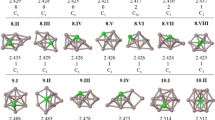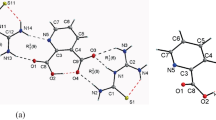Conclusions
-
1.
The complex method of NMR on several nuclei (carbon, nitrogen, oxygen) can be used successfully to solve problems of the fine structure of organic compounds.
-
2.
A single system of three types of nuclei (carbon, nitrogen, and oxygen), lying at the basis of the anions of aliphatic nitrocompounds, was investigated by the indicated method, which yielded sufficiently complete and direct information on the electronic structure of these anions.
-
3.
The principles observed in the spectra of N14, C13, and O17 in the transition from nonionized nitrocompounds to their analogs, are evidence of the equivalence of all the nitro groups in polynitroanions in solution, of the predominant concentration of negative charge in the anions on the oxygen atoms of the nitro groups, and of its uniform distribution between them, as well as the presence of double bonding of the α-carbon atom.
Similar content being viewed by others
Literature cited
É. T. Lippmaa, M. Ya. Myagi, Ya. O. Past, S. A. Shevelev, V. I. Erashko, and A. A. Fainzil'-berg, Izv. Akad. Nauk SSSR, Ser. Khim., 1006 (1971).
F. Williams, P. Flanagan, W. Taylor, and H. Shechter, J. Organ. Chem.,30, 2674 (1965).
D. Herbison-Evans and R. Richards, Mol. Phys.,7, 515 (1964).
M. Witanowski, J. Amer. Chem. Soc.,90, 5683 (1968).
A. Saika and C. Slichter, J. Chem. Phys.,22, 26 (1954).
J. Pople, J. Chem. Phys.,37, 53, 60 (1962).
M. Karplus and J. Pople, J. Chem. Phys.,38, 2803 (1963).
M. Kamlet and D. Glover, J. Organ. Chem.,27, 537 (1962).
M. Witanowski, T. Urbanski, and L. Stefaniak, J. Amer. Chem. Soc.,86, 2569 (1964).
M. Witanowski and L. Stefaniak, J. Chem. Soc., B, 1061 (1967).
N. V. Grigor'eva, and N. V. Margolis, I. N. Shokhor, V. V. Mel'nikov, and I. V. Tselinskii, Zh. Strukt. Khim.,7, 278 (1966);9, 550 (1968).
N. G. Golovina and L. O. Atovmyan, Zh. Strukt. Khim.,8, 307 (1967).
I. N. Shokhor, I. V. Tselinskii, A. G. Gal'kovskaya, and V. V. Mel'nikov, Zh. Organ. Khim.,3, 489 (1967).
V. I. Erashko, S. A. Shevelev, A. A. Fainzil'berg, M. Ya. Myagi, and É. T. Lippmaa, Izv. Akad. Nauk SSSR, Ser. Khim., 958 (1970).
V. I. Slovetskii, S. A. Shevelev, V. I. Erashko, A. A. Fainzil'berg, and S. S. Novikov, Izv. Akad. Nauk SSSR, Otd. Khim., 57 (1963).
V. I. Slovetskii, V. I. Erashko, and M. K. Orlova, Izv. Akad. Nauk SSSR, Ser. Khim., 1291 (1970).
H. Christ, P. Diehl, H. Schneider, and H. Dahn, Helv. Chim. Acta.,44, 865 (1961).
N. Jonathan, J. Molec. Spectr.,7, 105 (1961).
Author information
Authors and Affiliations
Additional information
Translated from Izvestiya Akademii Nauk SSSR, Seriya Khimicheskaya, No. 5, pp. 1012–1016, May, 1971.
Rights and permissions
About this article
Cite this article
Lippmaa, É.T., Myagi, M.Y., Past, Y.O. et al. Investigation of the structure of anions of aliphatic nitrocompounds by the method of NMR on C13, N14, and O17 nuclei. Russ Chem Bull 20, 929–932 (1971). https://doi.org/10.1007/BF00862197
Received:
Issue Date:
DOI: https://doi.org/10.1007/BF00862197




